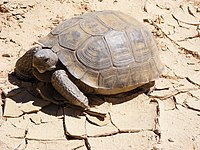
Photo from wikipedia
Abstract Sampling fecal droppings (scat) to genetically identify individual animals is an established method for monitoring mammal populations and could be highly useful for monitoring reptile populations. Whereas existing protocols… Click to show full abstract
Abstract Sampling fecal droppings (scat) to genetically identify individual animals is an established method for monitoring mammal populations and could be highly useful for monitoring reptile populations. Whereas existing protocols for obtaining DNA from reptile scat focus on analyses of whole, fresh scat deposited during animal handling, the collection of scat naturally deposited by reptiles in situ, as required for non‐invasive population monitoring, requires protocols to extract highly degraded DNA. Using surface swabs from such scats can reduce PCR inhibition and increase genotyping success. We report on three related but independently designed studies of DNA analyses from scat swabs of herbivorous reptiles under natural desert conditions: two free‐ranging desert tortoise species (Agassiz's desert tortoise, Gopherus agassizii, California, US, and Morafka's desert tortoise, G. morafkai, Arizona, US) and the common chuckwalla (Sauromalus atar) (Arizona, US, and Sonora, MX). We analyzed samples from both tortoise species with the same set of 16 microsatellites and chuckwalla samples with four mtDNA markers; studies also varied in swab preservation medium and DNA extraction method. Microsatellite amplification success per sample, defined as ≥9 loci with amplification, was 15% for the study of Agassiz's desert tortoise and for the study of 42% Morafka's desert tortoise. For chuckwallas, we successfully amplified and sequenced 50% of samples. We recovered fragments up to 400 bp for tortoises and 980 bp for chuckwallas from scat swab samples. This study indicates that genotypes can successfully be obtained from swabs of scat from herbivorous reptiles collected in the field under natural environmental conditions and emphasizes that repeat amplifications are necessary for the genetic identification of individuals from non‐invasive samples.
Journal Title: Ecology and Evolution
Year Published: 2022
Link to full text (if available)
Share on Social Media: Sign Up to like & get
recommendations!